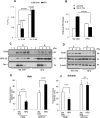CD36- and GPR120-mediated Ca²⁺ signaling in human taste bud cells mediates differential responses to fatty acids and is altered in obese mice
- PMID: 24412488
- PMCID: PMC3979457
- DOI: 10.1053/j.gastro.2014.01.006
CD36- and GPR120-mediated Ca²⁺ signaling in human taste bud cells mediates differential responses to fatty acids and is altered in obese mice
Abstract
Background & aims: It is important to increase our understanding of gustatory detection of dietary fat and its contribution to fat preference. We studied the roles of the fat taste receptors CD36 and GPR120 and their interactions via Ca(2+) signaling in fungiform taste bud cells (TBC).
Methods: We measured Ca(2+) signaling in human TBC, transfected with small interfering RNAs against messenger RNAs encoding CD36 and GPR120 (or control small interfering RNAs). We also studied Ca(2+) signaling in TBC from CD36(-/-) mice and from wild-type lean and obese mice. Additional studies were conducted with mouse enteroendocrine cell line STC-1 that express GPR120 and stably transfected with human CD36. We measured release of serotonin and glucagon-like peptide-1 from human and mice TBC in response to CD36 and GPR120 activation.
Results: High concentrations of linoleic acid induced Ca(2+) signaling via CD36 and GPR120 in human and mice TBC, as well as in STC-1 cells, and low concentrations induced Ca(2+) signaling via only CD36. Incubation of human and mice fungiform TBC with lineoleic acid down-regulated CD36 and up-regulated GPR120 in membrane lipid rafts. Obese mice had decreased spontaneous preference for fat. Fungiform TBC from obese mice had reduced Ca(2+) and serotonin responses, but increased release of glucagon-like peptide-1, along with reduced levels of CD36 and increased levels of GPR120 in lipid rafts.
Conclusions: CD36 and GPR120 have nonoverlapping roles in TBC signaling during orogustatory perception of dietary lipids; these are differentially regulated by obesity.
Keywords: GLP-1; Linoleic Acid; Lipids; Serotonin.
Copyright © 2014 AGA Institute. Published by Elsevier Inc. All rights reserved.
Figures







Similar articles
-
Orosensory Detection of Dietary Fatty Acids Is Altered in CB₁R-/- Mice.Nutrients. 2018 Sep 21;10(10):1347. doi: 10.3390/nu10101347. Nutrients. 2018. PMID: 30241419 Free PMC article.
-
Ca2+ signaling in taste bud cells and spontaneous preference for fat: unresolved roles of CD36 and GPR120.Biochimie. 2014 Jan;96:8-13. doi: 10.1016/j.biochi.2013.06.005. Epub 2013 Jun 15. Biochimie. 2014. PMID: 23774298 Review.
-
CD36 and GPR120 mediated orogustatory perception of dietary lipids and its physiological implication in the pygmy mouse Mus booduga.J Anim Physiol Anim Nutr (Berl). 2022 Nov;106(6):1408-1419. doi: 10.1111/jpn.13755. Epub 2022 Jul 21. J Anim Physiol Anim Nutr (Berl). 2022. PMID: 35864815
-
The lipid-sensor candidates CD36 and GPR120 are differentially regulated by dietary lipids in mouse taste buds: impact on spontaneous fat preference.PLoS One. 2011;6(8):e24014. doi: 10.1371/journal.pone.0024014. Epub 2011 Aug 25. PLoS One. 2011. PMID: 21901153 Free PMC article.
-
Cell mechanisms of gustatory lipids perception and modulation of the dietary fat preference.Biochimie. 2014 Dec;107 Pt A:11-4. doi: 10.1016/j.biochi.2014.06.018. Epub 2014 Jul 2. Biochimie. 2014. PMID: 24997404 Review.
Cited by
-
Western Diet Induced Remodelling of the Tongue Proteome.Proteomes. 2021 May 12;9(2):22. doi: 10.3390/proteomes9020022. Proteomes. 2021. PMID: 34066295 Free PMC article.
-
Tongue Leptin Decreases Oro-Sensory Perception of Dietary Fatty Acids.Nutrients. 2021 Dec 31;14(1):197. doi: 10.3390/nu14010197. Nutrients. 2021. PMID: 35011070 Free PMC article.
-
Novel GPR120 agonist TUG891 modulates fat taste perception and preference and activates tongue-brain-gut axis in mice.J Lipid Res. 2020 Feb;61(2):133-142. doi: 10.1194/jlr.RA119000142. Epub 2019 Dec 5. J Lipid Res. 2020. PMID: 31806728 Free PMC article.
-
The effect of maternal period nutritional status on oro-sensorial fat perception and taste preference in rats.Mol Cell Biochem. 2023 Dec;478(12):2861-2873. doi: 10.1007/s11010-023-04703-5. Epub 2023 Mar 21. Mol Cell Biochem. 2023. PMID: 36943662
-
Human Tongue Electrophysiological Response to Oleic Acid and Its Associations with PROP Taster Status and the CD36 Polymorphism (rs1761667).Nutrients. 2019 Feb 1;11(2):315. doi: 10.3390/nu11020315. Nutrients. 2019. PMID: 30717278 Free PMC article.
References
-
- Khan NA, Besnard P. Oro-sensory perception of dietary lipids: New insights into the fat taste transduction. Biochim Biophys Acta. 2009;1791:149–155. - PubMed
-
- Fukuwatari T, Kawada T, Tsuruta M, et al. Expression of the putative membrane fatty acid transporter (FAT) in taste buds of the circumvallate papillae in rats. FEBS Lett. 1997;414:461–464. - PubMed
-
- El-Yassimi A, Hichami A, Besnard P, et al. Linoleic acid induces calcium signaling, SRC-kinase phosphorylation and neurotransmitters release in mouse CD36-positive gustatory cells. J Biol Chem. 2008;283:12949–12959. - PubMed
Publication types
MeSH terms
Substances
Grants and funding
LinkOut - more resources
Full Text Sources
Other Literature Sources
Medical
Molecular Biology Databases
Miscellaneous

